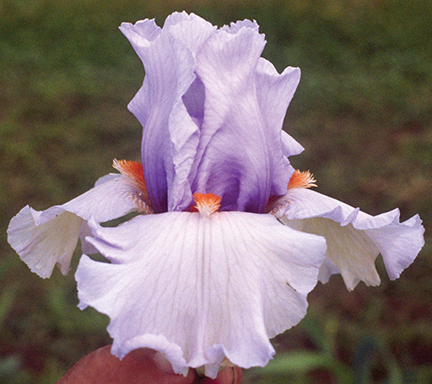Tall Bearded Iris
Growing Tall Bearded Iris and Memories in Kansas City
If you are reading this magazine, then you probably already have much experience with Tall Bearded iris. Maybe like me, a friend gave you a fan of leaves with a small bulb on the bottom and said, “plant this, it’s purple.” Hopefully, you took their advice and discovered just how rewarding growing iris can be.
Tall bearded iris are easily used in many different types of gardens. Soft and subtle varieties like ‘Beverly Sills’ float like mystical fairies over peonies in the spring. Bold and brash colored iris draw the eye like a neon sign. Used in mass, their leaves can be the backdrop to an annual flower border. A unique-looking iris can become the garden focal point as a solitary specimen.
Iris is the Greek word for rainbow and tall bearded iris are known to come in every color except red. Sunny ‘Galactic Gold’ and ‘Janet Lemon’ extend yellow tones in spring after the daffodils fade. Dramatic bearded iris with names like ‘Black Attack’, and ‘Coal Seams’ represent some of the darkest flowers found in any garden.
When choosing an iris, descriptions talk about falls, which are the petals that droop down at the bottom of the flower. The Standards are the petals that stick straight up and the beard is the fuzzy part between the two.
Tall bearded iris can have thousands of variations and patterns. Speckles, lines, bordered-petals and ombre effects are just the tip of the iceberg when describing these garden gems.
Air circulation is the most important thing to give tall bearded iris. They are forgiving about dry conditions, but they do not like to sit in water. Tall bearded iris prefer to be planted with a little bit of the bulb above the soil and most pests and diseases can be prevented by keeping the tubers clear of weeds and debris.
Once established, tall bearded iris will perform best if they are divided every few years. Fast growing varieties need a division every three years. Others are slow and can move to the bottom of the “Honey-Do” list.
Visit growers, like Comanche Acres Iris Garden, located in Gower, Mo. (www.comancheacresiris.com), in May and June, when iris are in bloom. Float around like a bee, through fields planted with more varieties than one can count. The best time to plant iris is late summer, so you have plenty of time to decide which ones you want.
Another opportunity to see Kansas City’s tall bearded iris in bloom is at Powell Gardens. In a garden area called Iris Hill, members of the American Iris Society (AIS) care for over 500 award-winning varieties.
Iris Hill was originally established by Dr. Norlan Henderson, a retired UMKC botany professor and iris breeder. Everyone at Powell Gardens knew “Doc” to be an amazing force. He passed away earlier this year at the age of 100. Alan Branhagen, Powell Gardens Director of Horticulture, respected Doc, not only as an educator, but also as a great friend.
“He was at Powell Gardens every day during iris bloom season in May and his sharing the special quality and beauty of each variety’s flowers was infectious,” remembers Branhagen.
Iris not only beautify our gardens, they also bring people together and create fond memories. This spring when the bearded iris bloom, I will look at my garden and remember my friend Doc and the time that he gave me that funny little fan of leaves, and he said, “plant this. It’s purple.” I am glad that I did.
Tracy Flowers is on the Horticulture staff at Powell Gardens and she works at The Ewing and Muriel Kauffman Memorial Garden. You may reach her at 816-932-1200.
To view more iris images, see them in the online version of the March 2016 issue at KCG Mar16 issue.

